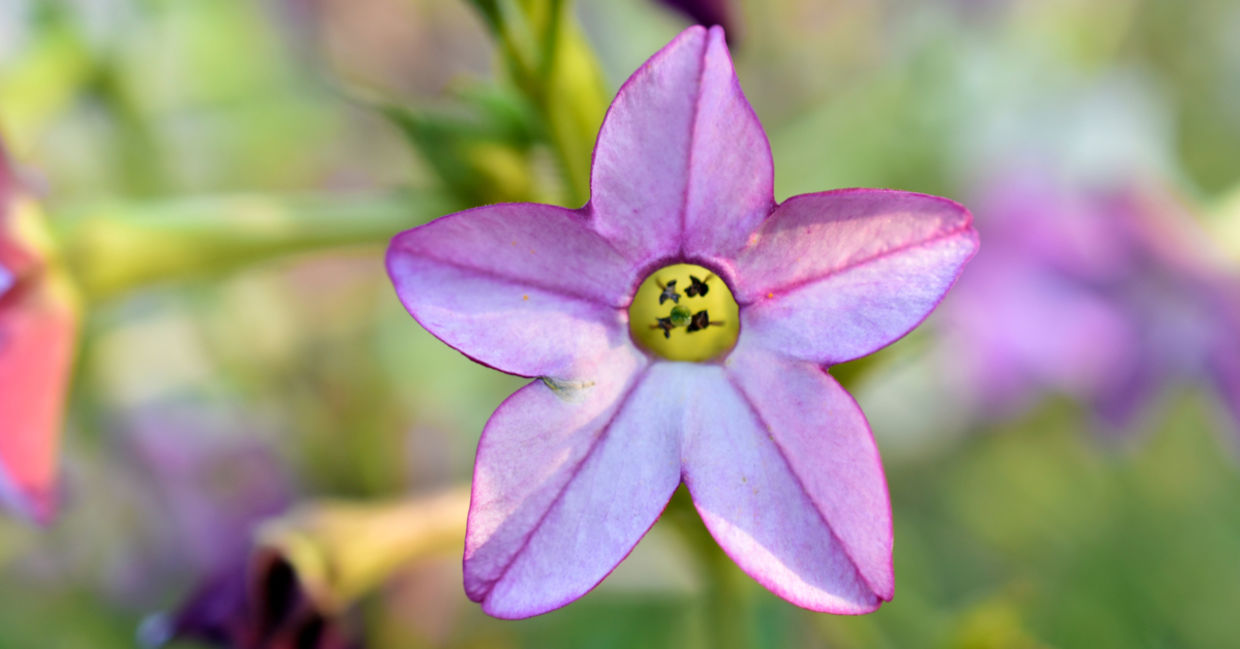
(Vogdux / Shutterstock.com)
Picture this. Your end of the day me time is finally here, and you step out into your yard or balcony to be greeted by the opulent aromas of your night garden. This is brimming with pale flowers attracting important pollinators in the darkness, and moonlit, silvery foliage.
Your moon garden is a sanctuary of flowers that reserve their most aromatic scents for the evening, perfectly in sync with your arrival. It is where you can sit and take in the view and the scents!
If this sounds like an inviting scenario for relaxing, after-dark enjoyment, check out these seven night-loving flowers to create your own perfumed haven.
Nicotiana
Also known as tobacco flowers, nicotiana are star-shaped. Just like stars, these shine at night, and this is when these exquisite flowers begin their perfumed performance.
The freesia-like scent of the nicotiana flower attracts bumble bees, offering a honey buffet for hungry insects.
This flower adds a splash of colour to a flower bed or pots, and comes in pinks, purples, deep reds, whites and even pale green.

(Lushchikov Valeriy / Shutterstock.com)
Night-blooming Cereus
The night-blooming cereus has been given several romanticized names including queen of the night. The short lived white blooms of this cactus, which are nine inches across, release a rich, floral aroma with a soft, spicy undertone that can perfume an entire garden.
Native to Arizona and the Sonoran desert in the southwestern United States, it thrives in warmer climates.
The rarity and difficulty of predicting when this large flower will bloom can make witnessing it a mark of status. This is what happens in Kevin Kwan’s 2013 novel, Crazy Rich Asians, when the clan gathers to watch its fleeting glory.

(Jill Shepherd / Shutterstock.com)
Moonflower
The moonflower is a species of night-blooming morning glory native to tropical and subtropical parts of North and South America.
It is considered one of the most romantic plants that can be grown in a garden. Its large, trumpet-shaped blooms unfurl from the late afternoon onwards, and remain open until the sun rises. Several varieties give off a lemon fragrance when the flowers are open. Its large, heart-shaped leaves are also part of the appeal.

(Poetra.RH / Shutterstock.com)
Tuberose
Tuberose is not related to roses, but is a distant relative of the hyacinth. This was a Victorian favorite. Its mass of white blooms and graceful form make it a frequent choice for bridal bouquets.
But Tuberose is especially prized for its white floral and sweet night time scent, with the many white “bells” of the flower spreading an exquisite aroma that is compared to jasmine and honey with a deeper undertone. While it opens in the day, it grows more potent after sundown.
Tuberose is said to be the most fragrant plant in the plant world. Unsurprisingly, it features in many perfumes. Originating in Mexico, where Aztecs used it to perfume chocolate, the flower was taken to Morocco, Egypt and China. In the 17th century, it was exported to Europe from India.

(wasanajai / Shutterstock.com)
Night-blooming Jasmine
“From plants that wake when others sleep, from timid jasmine buds that keep their odour to themselves all day, but when the sunlight dies away let the delicious secret out to every breeze that roams about.”
So wrote poet Thomas Moore, describing the intoxicating aroma of night-blooming jasmine that only shares its aromatic promise after dark.
Yes, the tubular flowers of night-blooming jasmine are tiny, but at night their heavenly perfume spreads 20 feet! Because of this scent, this tropical plant is commonly planted near the home or patio where its perfume can be enjoyed.
In fact, this plant is not a member of the jasmine family at all but of the jessamine one. But the names and fragrant blooms are easily confused.

(Satoshi Mizushima / Shutterstock.com)
Night Phlox
Night phlox aka midnight candy, is a low-growing perennial plant native to South Africa. It is prized for its numerous white blooms which open at night to release a beautiful fragrance reminiscent of cake ingredients like honey, almonds and vanilla. Its scent combines well with the sweet scents of other night-blooming flowers.
Blooms can also be purple and maroon, and gardening knowhow recommends planting them near an outdoor seating area, or in moveable containers, to maximally enjoy the fragrance.

(Foxxy63 / Shutterstock.com)
Petunia
Petunias, with their beautiful velvety blooms which come in white and an array of jewel-toned hues, are easy to grow and release a heady, pleasing floral scent after dark to attract pollinators.
A University of Washington study concluded that these flowers know when to smell good, linking the plant’s production and release of these fragrant chemicals to the innate circadian rhythms that pulse through all life on Earth.

(Prolhorova Nataliia / Shutterstock.com)







